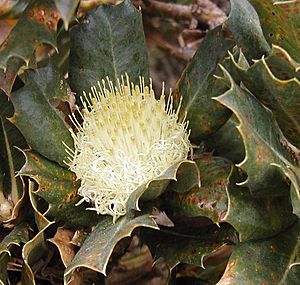George's taxonomic arrangement of Dryandra facts for kids

Imagine trying to organize a huge collection of plants! That's what a scientist named Alex George did for a group of plants called Dryandra. He created the first modern way to sort and name them. His system was first shared in a science journal called Nuytsia in 1996. It replaced an older system that had been used for over a hundred years! Later, George's work became the base for a big book series called Flora of Australia. At the time, Dryandra was seen as its own group, or genus. George divided this genus into three main subgroups, and the biggest subgroup had 24 smaller groups called series. This system was used until 2007. That's when Dryandra plants were moved into the Banksia group and became known as Banksia series Dryandra. No one has suggested a different way to organize them since then.
Contents
What are Dryandras?
The dryandras are a group of 94 different kinds of plants, also known as species. They belong to the plant family called Proteaceae. These plants only grow in the southwest part of Western Australia. They can be small plants that spread low to the ground, called prostrate shrubs, or even small trees. The name Dryandra was first used for this group of plants in 1810. Even in the 1990s, when Alex George did his work, it was still thought of as its own main group of plants.
Alex George's Plant Family Tree
Alex George's way of organizing Dryandra plants was first published in 1996. He wrote an article called "New taxa and a new infragenetic classification in Dryandra R.Br. (Proteaceae: Grevilleoideae)". This article appeared in the science journal Nuytsia. His ideas from this article were then used for the Flora of Australia book series in 1999. In that book, he even named one new species of plant! Later, in 2005, he added six more new types of plants to his system.
Why the Change? Dryandra Joins Banksia
Alex George's system was used for many years. But in 2007, two other scientists, Austin Mast and Kevin Thiele, decided that Dryandra plants should actually be part of the Banksia group. They weren't ready to create a whole new way to organize them. So, to make the change simple, they moved Dryandra into Banksia as a "series." This meant George's original system for Dryandra was put aside. When Mast and Thiele made this change, they accidentally missed the six new types of plants George had named in 2005. So, those six plants still have their old Dryandra names, which are now technically not correct.
How Alex George Organized Dryandras
Here's a simplified look at how Alex George organized the Dryandra plants, including the changes from 2005. Remember, all these Dryandra names are now part of the Banksia group!
- Genus Dryandra (now called Banksia series Dryandra)
- Subgenus Dryandra
- Series Floribundae
- D. sessilis (now B. sessilis)
- Series Armatae
- D. cuneata (now B. obovata)
- D. fuscobractea (now B. fuscobractea)
- D. armata (now B. armata)
- Series Marginatae
- D. pulchella (now B. bella)
- Series Folliculosae
- D. fraseri (now B. fraseri)
- Series Acrodontae
- D. sclerophylla (now B. sclerophylla)
- D. kippistiana (now B. kippistiana)
- Series Capitellatae
- D. serratuloides (now B. serratuloides)
- D. meganotia (now B. meganotia)
- Series Ilicinae
- D. praemorsa (now B. undata)
- D. quercifolia (now B. heliantha)
- Series Dryandra
- D. formosa (now B. formosa)
- D. nobilis (now B. nobilis)
- Series Foliosae
- D. mucronulata (now B. mucronulata)
- D. baxteri (now B. biterax)
- Series Decurrentes
- D. comosa (now B. comosa)
- Series Tenuifoliae
- Series Runcinatae
- D. ferruginea (now B. rufa)
- D. corvijuga (now B. corvijuga)
- Series Triangulares
- D. drummondii (now B. drummondii)
- D. octotriginta (now B. octotriginta)
- Series Aphragma
- D. pteridifolia (now B. pteridifolia)
- D. fililoba (now B. fililoba)
- Series Ionthocarpae
- D. ionthocarpa (now B. ionthocarpa)
- Series Inusitatae
- D. idiogenes (now B. idiogenes)
- Series Subulatae
- D. subulata (now B. subulata)
- Series Gymnocephalae
- D. cynaroides (now B. cynaroides)
- D. erythrocephala (now B. erythrocephala)
- Series Plumosae
- D. plumosa (now B. plumosa)
- D. pseudoplumosa (now B. pseudoplumosa)
- Series Concinnae
- D. concinna (now B. concinna)
- D. serra (now B. serra)
- Series Obvallatae
- D. fasciculata (now B. fasciculata)
- D. conferta (now B. densa)
- Series Pectinatae
- D. nana (now B. nana)
- Series Acuminatae
- D. preissii (now B. acuminata)
- Series Niveae
- D. arctotidis (now B. arctotidis)
- D. tortifolia (now B. tortifolia)
- Series Floribundae
- Subgenus Hemiclidia
-
- D. falcata (now B. falcata)
- D. glauca (now B. glaucifolia)
-
- Subgenus Diplophragma
-
- D. bipinnatifida (now B. bipinnatifida)
-
- Subgenus Dryandra

